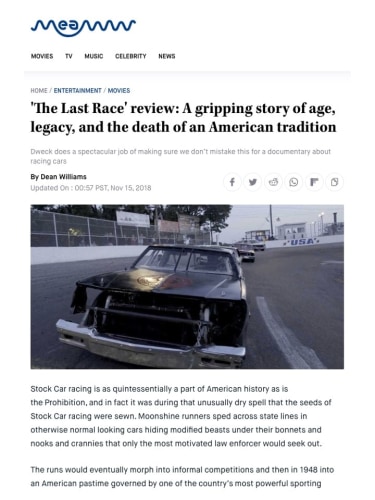'The Last Race' review: A gripping story of age, legacy, and the death of an American tradition
Meaww
11/15/2018
Back
Dweck does a spectacular job of making sure we don’t mistake this for a documentary about racing cars
By Dean Williams
Stock Car racing is as quintessentially a part of American history as is the Prohibition, and in fact it was during that unusually dry spell that the seeds of Stock Car racing were sewn. Moonshine runners sped across state lines in otherwise normal looking cars hiding modified beasts under their bonnets and nooks and crannies that only the most motivated law enforcer would seek out.
The runs would eventually morph into informal competitions and then in 1948 into an American pastime governed by one of the country’s most powerful sporting bodies: NASCAR (National Association for Stock Car Auto Racing). But these days NASCAR races are a far cry from those envisioned by the hobbyists, petrolheads, and weekend warriors that formed the base of Stock Car racing. For a while race tracks sprung up across the country, hosting amateur and professional races over the weekend. The tracks became epicentres of community, and around them grew bonds that transcended pistons and crankshafts. Dreams were realized and crushed, fists flew, and cars crashed and burned, but in the end it was all part of the thrill and pomp of Stock Car racing.
'The Last Race', which releases on streaming services and select theatres on November 16, is about one such epicenter in Long Island, in fact the last of its kind in the area. Long Island is often referred to as the birthplace of Stock Car racing, and the Riverhead Raceway has been owned and run by 87-year-old Barbara and Jim Cromarty since they bought the track back in 1977. And quite honestly Riverhead should by now be a strip mall, or blocks of condominiums...anything but a raceway.
All around it are the concrete signs of a community on the up, one of the millions of telltale signs across the country that tell us prosperity's best impression is the monolith we build to it. And therein lies the focus of Michael Dweck’s documentary with Magnolia Films: How a vestige of a past trapped in razor-wired innocence can buck every modern trend. Are the Cromartys simply obstinate for refusing to sell as the offers roll in? Are they simply the caretakers of something far more precious than a pedestal to ‘development'; a piece of the original American verve? It’s a bit of both.
As Dweck guides us through the track and its raceday denizens, it’s easy to see this is a labour of love, but he’s left the blinkers at home. The Cromartys are sculpted gatekeepers, selling tickets for a show that has circled the wagons while the ‘enemies’ hoot and holler around them.
There is a scene of Jim Cromarty trying to open a parcel with his teeth. At first you want to laugh because, well, it looks rather funny. But then you realize that you’re watching an ageing man struggle with a seemingly innocuous wrapping. He doesn’t reach for an implement to make his task easier, he doesn’t ask for help. The Sisyphean imagery is hard to miss, and a certain sadness impinges on the humor we first felt. Barbara doesn't even look at him as he struggles, she simply stares off into an unseen distance, intently watching the unfolding of some scene long since deleted by a majority of those who observed it.
Riverhead Raceway's magic lies in the fact that it is enmeshed in another age. From race announcer Bob Finan’s commentary (and the fact that he can’t actually see one corner of the oval from his booth) to the racers themselves: Drivers still clinging on to past glories, laying out their trophies, beaming with pride. Dweck does a spectacular job of making sure we don’t mistake this for a documentary about racing cars. How can you when, all around, the imagery casts a shroud that blankets over the central figures, almost pushing them to the door marked ‘exit’, all the while espousing the road that took them there.
The Last Race is a film about America. Not the politically rift-riven chaotic country beamed into our living room every day, but the one that matters most...the one built, loved and cared for by its people.
The Last Race is a story of community, of dreams, and the catharsis of speed and the prospect of flames. But it is also a story of age and legacy and how the former can cling to the latter with ferocious strength, long after the need to do so has fled.
Barbara and Jim Cromarty eventually sold Riverhead and retired. But no steel towers have risen, no food courts litter the banks, and on the weekends you can still here the roar of engines and smell the gas and rubber. Riverhead Raceway lives on even after its sentinels have left. For how much longer? Who can say, but then that’s pretty much the answer to everything. Let’s enjoy it while it’s still around, Barbara and Jim would have wanted it that way.